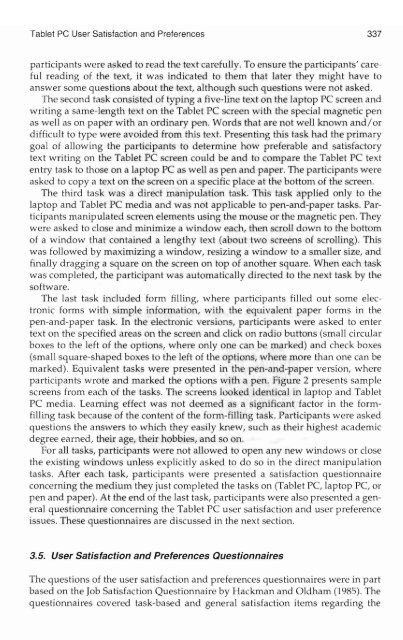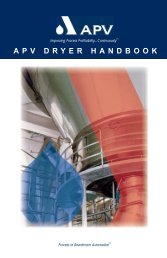A Comparative Study Between Tablet and Laptop PCs: User ... - Umbc
A Comparative Study Between Tablet and Laptop PCs: User ... - Umbc
A Comparative Study Between Tablet and Laptop PCs: User ... - Umbc
You also want an ePaper? Increase the reach of your titles
YUMPU automatically turns print PDFs into web optimized ePapers that Google loves.
<strong>Tablet</strong> PC <strong>User</strong> Satisfaction <strong>and</strong> Preferences 337<br />
participants were asked to read the text carefully. To ensure the participants' careful<br />
reading of the text, it was indicated to them that later they might have to<br />
answer some questions about the text, although such questions were not asked.<br />
The second task consisted of typing a five-line text on the laptop PC screen <strong>and</strong><br />
writing a same-length text on the <strong>Tablet</strong> PC screen with the special magnetic pen<br />
as well as on paper with an ordinary pen. Words that are not well known <strong>and</strong>/or<br />
difficult to type were avoided from this text. Presenting this task had the primary<br />
goal of allowing the participants to determine how preferable <strong>and</strong> satisfactory<br />
text writing on the <strong>Tablet</strong> PC screen could be <strong>and</strong> to compare the <strong>Tablet</strong> PC text<br />
entry task to those on a laptop PC as well as pen <strong>and</strong> paper. The participants were<br />
asked to copy a text on the screen on a specific place at the bottom of the screen.<br />
The third task was a direct manipulation task. This task applied only to the<br />
laptop <strong>and</strong> <strong>Tablet</strong> PC media <strong>and</strong> was not applicable to pen-<strong>and</strong>-paper tasks. Participants<br />
manipulated screen elements using the mouse or the magnetic pen. They<br />
were asked to close <strong>and</strong> minimize a window each, then scroll down to the bottom<br />
of a window that contained a lengthy text (about two screens of scrolling). This<br />
was followed by maximizing a window, resizing a window to a smaller size, <strong>and</strong><br />
finally dragging a square on the screen on top of another square. When each task<br />
was completed, the participant was automatically directed to the next task by the<br />
software.<br />
The last task included form filling, where participants filled out some electronic<br />
forms with simple information, with the equivalent paper forms in the<br />
pen-<strong>and</strong>-paper task. In the electronic versions, participants were asked to enter<br />
text on the specified areas on the screen <strong>and</strong> click on radio buttons (small circular<br />
boxes to the left of the options, where only one can be marked) <strong>and</strong> check boxes<br />
(small square-shaped boxes to the left of the options, where more than one can be<br />
marked). Equivalent tasks were presented in the pen-<strong>and</strong>-paper version, where<br />
participants wrote <strong>and</strong> marked tne options with a pen. Figure 2 presents sample<br />
screens from each of the tasks. The screens looked identical in laptop <strong>and</strong> <strong>Tablet</strong><br />
PC media. Learning effect was not deemed as a significant factor in the formfilling<br />
task because of the content of the form-filling task. Participants were asked<br />
questions the answers to which they easily knew, such as their highest academic<br />
degree earned, their age, their hobbies, <strong>and</strong> so on.<br />
For aU tasks, participants were not allowed to open any new windows or close<br />
the existing windows unless explicitly asked to do so in the direct manipulation<br />
tasks. After each task, participants were presented a satisfaction questionnaire<br />
concerning the medium they just completed the tasks on (<strong>Tablet</strong> PC, laptop PC, or<br />
pen <strong>and</strong> paper). At the end of the last task, participants were also presented a general<br />
questionnaire concerning the <strong>Tablet</strong> PC user satisfaction <strong>and</strong> user preference<br />
issues. These questionnaires are discussed in the next section.<br />
3.5. <strong>User</strong> Satisfaction <strong>and</strong> Preferences Questionnaires<br />
The questions of the user satisfaction <strong>and</strong> preferences questionnaires were in part<br />
based on the Job Satisfaction Questionnaire by Hackman <strong>and</strong> Oldham (1985). The<br />
questionnaires covered task-based <strong>and</strong> general satisfaction items regarding the











